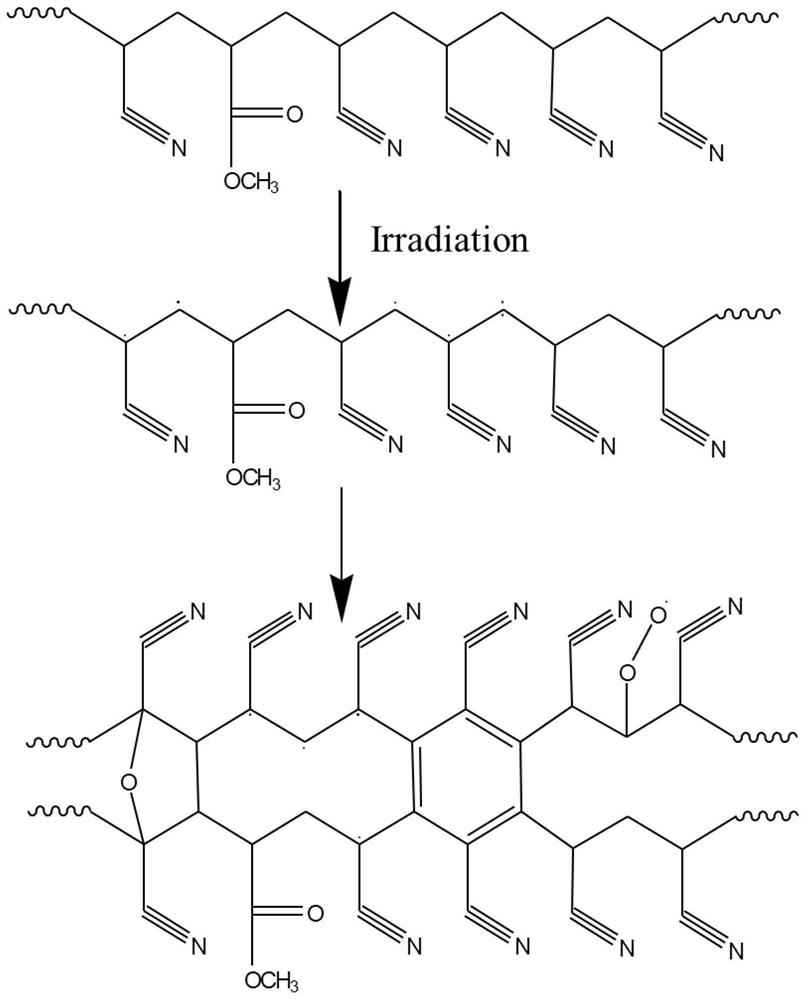A preparation method of cofs@hpan nanofiltration composite membrane
A composite membrane and nanofiltration technology, applied in chemical instruments and methods, membrane technology, semi-permeable membrane separation, etc., can solve the problem of chemical resistance and cycle stability that have not been reported, and hybrid membranes with poor mechanical properties and service stability , anti-pollution and unstable flux recovery rate, etc., to achieve the effects of excellent cycle stability, eliminating solvent recovery and three waste treatment, excellent permeability and selectivity
- Summary
- Abstract
- Description
- Claims
- Application Information
AI Technical Summary
Problems solved by technology
Method used
Image
Examples
preparation example Construction
[0023] The invention provides a method for preparing a COFs@HPAN nanofiltration composite membrane (method for short), which is characterized in that the method comprises the following steps:
[0024] 1) Add COFs and meltable PAN-based copolymers into a twin-rotor high-speed mixer, and mix at a speed of 500-1500 rpm and a temperature of 200-230°C for 5-60 minutes to obtain COFs-PAN masterbatch;
[0025] In step 1), the meltable PAN-based copolymer can be prepared using the materials or preparation methods disclosed in patent ZL201510694690.X or ZL200810053936.5.
[0026] In step 1), the COFs can be but not limited to COF-1 (pore size 1.5nm), COF-5 (pore size 2.7nm), COF-8 (pore size 1.64nm), COF-10 (pore size 3.2nm), COF -DhaTab (pore diameter 3.7nm), COF-TpPa-1 (pore diameter 1.8nm), COF-TpPa-2 (pore diameter 1.5nm), COF-TpBD (pore diameter 2.4nm), COF-TpBD-Me 2 (pore size 2.3nm), COF-TpBD-(OMe) 2 At least one of (pore diameter 2.3nm), COF-TpTGcl (pore diameter 1.3nm), COF-...
Embodiment 1
[0055] 1) Add 50g COF-TpBD-Me 2 Mix with 200g of meltable PAN at 1000rpm and 210°C for 20min to prepare COF-TpBD-Me 2 COFs-PAN masterbatch with a content of 20wt%;
[0056] 2) Stir the composite diluent composed of 180g COFs-PAN masterbatch, 700g caprolactam and 320g glycerol triacetate at 150°C under the protection of nitrogen for 3 hours and defoam for 24 hours to obtain a uniform and foam-free casting solution; The film solution was poured into a mold at 110°C for calendering, and after curing in an air bath at 25°C for 12 hours, the compound diluent was extracted and removed in an aqueous solution to obtain a COFs-PAN blend flat film;
[0057] 3) Primary cross-linking: put the COFs-PAN blend flat film obtained in step 2) into 10wt% NaOH solution for hydrolysis for 2 hours, rinse with ethanol and distilled water to remove NaOH on the film surface, and dry in a vacuum oven at 60°C for 24 hours Obtain the dry COFs@HPAN hybrid membrane;
[0058] Secondary cross-linking: put...
Embodiment 2
[0062] 1) Mix 100g of COF-TpPa-2 and 150g of meltable PAN at a speed of 500rpm and 200°C for 40min to prepare a COFs-PAN masterbatch with a COF-TpPa-2 content of 40wt%;
[0063] 2) Mix 220g COFs-PAN masterbatch, 810g caprolactam and 90g dibutyl sebacate in a composite diluent, stir for 3 hours at 160°C under argon protection, and defoam for 24 hours to obtain a uniform and foam-free casting film liquid; then pour the casting solution into a mold at 90°C for calendering, solidify in an air bath at 20°C for 10 hours, extract and remove the composite diluent in a mixed solution of water and ethanol, and obtain a COFs-PAN blended plate membrane;
[0064] 3) Primary cross-linking: put the COFs-PAN blend flat film obtained in step 2) into 25wt% KOH solution and hydrolyze for 0.5h, rinse with ethanol and distilled water to remove KOH on the film surface, and dry in a vacuum oven at 80°C 15h to obtain a dry COFs@HPAN hybrid membrane;
[0065] Secondary cross-linking: place it in an ...
PUM
| Property | Measurement | Unit |
|---|---|---|
| size | aaaaa | aaaaa |
| strength | aaaaa | aaaaa |
| strength | aaaaa | aaaaa |
Abstract
Description
Claims
Application Information
 Login to View More
Login to View More - R&D
- Intellectual Property
- Life Sciences
- Materials
- Tech Scout
- Unparalleled Data Quality
- Higher Quality Content
- 60% Fewer Hallucinations
Browse by: Latest US Patents, China's latest patents, Technical Efficacy Thesaurus, Application Domain, Technology Topic, Popular Technical Reports.
© 2025 PatSnap. All rights reserved.Legal|Privacy policy|Modern Slavery Act Transparency Statement|Sitemap|About US| Contact US: help@patsnap.com



